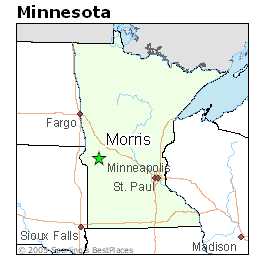 The above photo shows the Sam Smith statue silhouetted in twilight at Summit Cemetery in Morris. Photo by B.W.
The above photo shows the Sam Smith statue silhouetted in twilight at Summit Cemetery in Morris. Photo by B.W.The Sam Smith statue in Morris is a monument not only to the fighting spirit of the Union cause, but the perseverance of the early residents in Stevens County. The spirit projected by that statue, which depicts a charging Union soldier, was transferred to the early development of this area.
Smith was part of the wave of immigrants who signed on with the Union cause. He was a native of Germany, having been born near Frankfurt in 1839. His name wasn't even Samuel Smith, it was Christian Zimmerman. The name change evolved out of his war commitments.
He came to America to harness this nation's opportunities when he was age 16. He worked on a farm and at a sawmill in the Red Wing area. He was age 22 when the rebellion by the southern states broke out and America found itself in crisis. It was a defining, seminal and unique chapter in the country's evolution, and profoundly painful.
Zimmerman entered the military service as a "substitute" for a Winona man, Samuel Smith. It was a commonly accepted practice then for men of means to "buy" their way out of military service. (Dick Cheney used deferments.)
It seems amazing today that such a practice would not be torched by controversy. But apparently it was not, at least not to a degree that would be recorded in history books. Smith embarked on a road that would take him through iconic battles. He was wounded at First Manassas (a battle also called Bull Run, the first major engagement of the war that was viewed by Washington D.C. socialites from their carriages).
Smith was hurt while reloading his rifle.
(Some would use the term "musket" rather than rifle but the Civil War did usher in the age of the lethal "rifled gun" that dispensed bullets that would spin and thus be more deadly and accurate, helping explain the huge casualty numbers incurred. The aged generals tended to use tactics more consistent with the older technology, e.g. massed formations.)
Smith lost part of his right thumb.
Smith continued paying his war dues when in 1862, near Harpers Ferry, he was thrown from a wagon pulled by horses. A train startled the horses. He was crushed by the wheels and fortunate to survive. His lifelong trait of resilience would show through again.
Smith recovered from chest and back wounds and joined the ambulance corps. He and other members of the fabled First Minnesota Regiment were discharged in May of 1864. But the war would rage for a year longer. Some of the most grisly stages of the war came in the final year when the Confederacy was in its death throes.
Smith wasn't prepared to walk away from the conflict. He got back in, "substituting" for another individual this time. He took the place of a Sand Creek (Scott County) man. Now he was in the Second Minnesota - Company K. He joined the fabled trek of General William Sherman's forces to the sea. This time he did not have to serve under the other individual's name (for the record, Theis).
The Smith name was his destiny and the name that would get passed down through generations. Legally though it would be some time before "Smith" became affixed to him.
Those Smiths are still around here, carrying on their forebear's legacy of commitment.
Samuel left the service for good in July of 1865 and came back to Red Wing and the sawmill. Oh, the tales he could share.
The next chapter in this amazing person's life was to settle as a civilian and start a family that would include 12 children. It would have been interesting to ask him if that challenge matched that of wartime!
He got married two years after war's end to the former Catherine Hartman. Eleven of their 12 children were boys.
He attended a reunion of the First Minnesota in 1874 in Lake City. He came to Stevens County, settling in Rendsville Township, destined to farm and raise that large family with Catherine. He became active with the GAR (Grand Army of the Republic) post here. It wasn't until 1880 that he became a naturalized citizen.
About a decade later he made it official with Smith as his last name, probably to ease the process by which he received pension benefits as a veteran.
Catherine died in 1915. That same year saw Sam attend the GAR's 50th review in the nation's capital. On the way home he visited the Gettysburg battlefield. There he probably became inspired to have a replica statue made of the First Minnesota statue that graces those grounds. The replica would be placed on the Smiths' own burial plot here at Summit Cemetery.
A famous misconception grew that Sam was a model for the creation of the statue at Gettysburg. Research by Thomas Rice, a Civil War "round table" enthusiast, has demonstrated that the "model" story is almost certainly myth. Sam's obituary in the Morris newspaper noted that the deceased "erected a monument to the charge of the First Minnesota at Gettysburg where so many of his comrades fell."
The Smith monument was similar by design to the Gettysburg monument, as that design could not have been topped for paying tribute to the unit. But the "model" story, fun as it may be to spin, is fiction, it would appear.
Intrepid researcher Rice wrote that "most likely, Smith ordered his statue to be based upon the pose of the First Minnesota monument and a photo of himself."
Rice deserves real kudos. Just reading his stuff shows he feels optimal historical curiosity and the zeal of a detective. He is gentle on the myth-spinners with the following passage: "Concluding that (Smith) posed for the Gettysburg monument would be an easy error to make."
Rice lauds Smith as someone with "a sense of history and his place in it."
It is the American story, underlined: an immigrant captivated by the brimming frontiers and opportunity of this still-young country, and dedicated to its freedom.
The Union cause ensured that the most fundamental ideals of this country would thrive coast to coast. One united land.
Samuel Smith, RIP.
-Brian Williams - morris mn Minnesota - bwilly73@yahoo.com






















Samuel Smith is my great great grandfather. A lot of my family from the generations since him to my mother are buried in the same cemetery.
ReplyDelete